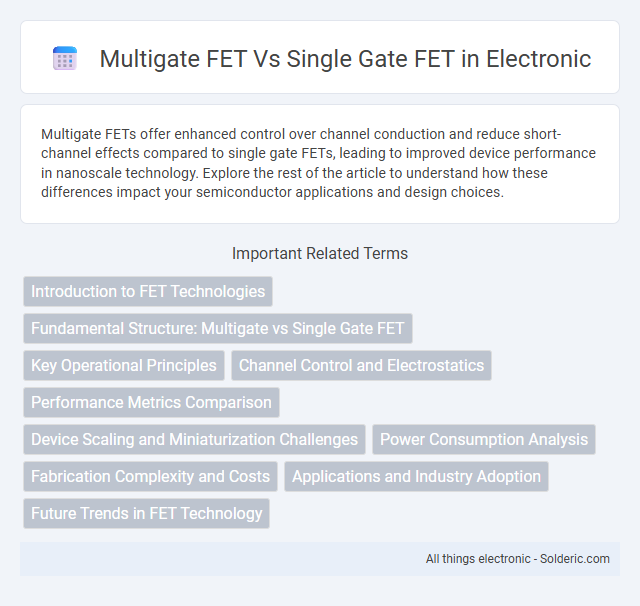Multigate FETs offer enhanced control over channel conduction and reduce short-channel effects compared to single gate FETs, leading to improved device performance in nanoscale technology. Explore the rest of the article to understand how these differences impact your semiconductor applications and design choices.
Comparison Table
| Feature | Multigate FET | Single Gate FET |
|---|---|---|
| Gate Structure | Multiple gates surrounding the channel | Single gate controlling the channel |
| Channel Control | Enhanced electrostatic control | Limited electrostatic control |
| Short Channel Effects | Significantly reduced | More pronounced |
| Scaling Capability | Better for nanoscale devices (sub-10 nm) | Limited scaling potential |
| Drive Current | Higher drive current due to improved conduction | Lower drive current |
| Leakage Current | Lower leakage current | Higher leakage current |
| Manufacturing Complexity | More complex and costly | Simpler and cost-effective |
| Examples | FinFET, Tri-Gate FET | Planar MOSFET |
Introduction to FET Technologies
Field-Effect Transistors (FETs) are essential components in modern electronics, with Single Gate FETs featuring a single gate controlling current flow, while Multigate FETs utilize multiple gates to enhance electrostatic control and reduce leakage currents. The advancement from Single Gate to Multigate FETs, such as FinFETs, allows for better scalability and performance in nanoscale semiconductor devices. Your choice between these technologies depends on factors like power efficiency, switching speed, and integration complexity in next-generation circuits.
Fundamental Structure: Multigate vs Single Gate FET
Multigate FETs feature multiple gates surrounding the channel, enhancing electrostatic control and reducing short-channel effects compared to single gate FETs, which have only one gate on top of the channel. This multi-dimensional gate structure in FinFETs or gate-all-around FETs enables better control over leakage currents and improved scalability for advanced semiconductor nodes. Single gate FETs face limitations in controlling channel behavior at nanoscale dimensions, leading to increased power consumption and reduced performance.
Key Operational Principles
Multigate FETs operate by controlling the current flow through multiple gates surrounding the channel, enhancing electrostatic control and reducing short-channel effects compared to single gate FETs that rely on a single gate electrode. This multi-gate configuration improves threshold voltage stability and drives current more efficiently, enabling better performance in nanoscale transistor designs. Your device benefits from improved switching speed and lower leakage current when using multigate FETs for advanced semiconductor applications.
Channel Control and Electrostatics
Multigate FETs offer superior channel control compared to Single gate FETs by surrounding the channel with multiple gates, effectively minimizing short-channel effects and enhancing electrostatic control. The improved gate electrostatics in Multigate FETs result in reduced leakage currents and better threshold voltage stability, crucial for scaling down transistor dimensions. Your device performance benefits from the tighter electrostatic integrity and enhanced current modulation inherent in Multigate structures.
Performance Metrics Comparison
Multigate FETs exhibit superior control over short-channel effects, resulting in higher drive currents and improved subthreshold slope compared to single gate FETs. The enhanced electrostatic control in multigate structures significantly reduces leakage currents, boosting overall device efficiency and switching speeds. Your circuit designs benefit from these performance metrics by achieving lower power consumption and higher integration density in advanced semiconductor technologies.
Device Scaling and Miniaturization Challenges
Multigate FETs significantly improve device scaling by offering enhanced electrostatic control over the channel, reducing short-channel effects compared to single gate FETs. The multiple gates surrounding the channel in Multigate FET designs enable aggressive miniaturization while maintaining performance and mitigating leakage currents. Single gate FETs struggle with threshold voltage variability and increased leakage currents as channel lengths shrink below 20 nm, limiting their scalability in advanced technology nodes.
Power Consumption Analysis
Multigate FETs exhibit significantly lower power consumption compared to single gate FETs due to enhanced electrostatic control, which reduces leakage currents and short-channel effects. The multiple gates improve gate control efficiency, allowing for reduced threshold voltage and lower operating voltages, resulting in decreased dynamic power dissipation. Consequently, Multigate FETs are preferred in low-power applications and advanced integrated circuits where energy efficiency is critical.
Fabrication Complexity and Costs
Multigate FETs exhibit higher fabrication complexity due to their intricate 3D structures requiring advanced lithography and multiple processing steps, which significantly increases production costs compared to single gate FETs. Single gate FETs benefit from simpler planar designs, enabling more cost-effective mass manufacturing with well-established semiconductor fabrication techniques. The increased manufacturing challenges of multigate FETs drive research into process optimization to balance performance improvements against the economic impact.
Applications and Industry Adoption
Multigate FETs are widely adopted in advanced semiconductor applications due to their superior control over short-channel effects, making them ideal for high-performance processors and low-power devices in the consumer electronics and automotive industries. Single gate FETs remain prevalent in simpler, cost-sensitive applications like analog circuits and legacy digital platforms where scaling requirements are less demanding. Your choice between these technologies depends on the performance needs and power efficiency targets dictated by the specific industry application.
Future Trends in FET Technology
Multigate FETs, including FinFETs and Gate-All-Around (GAA) transistors, enhance channel control and reduce short-channel effects, driving their adoption in sub-5nm semiconductor nodes. Single gate FETs, while simpler and cost-effective, face scalability limits due to increased leakage and performance degradation at nanoscale dimensions. The future of FET technology emphasizes extensive use of multigate architectures to meet the demands of higher speed, lower power consumption, and improved electrostatic integrity in advanced integrated circuits.
Multigate FET vs Single gate FET Infographic

 solderic.com
solderic.com